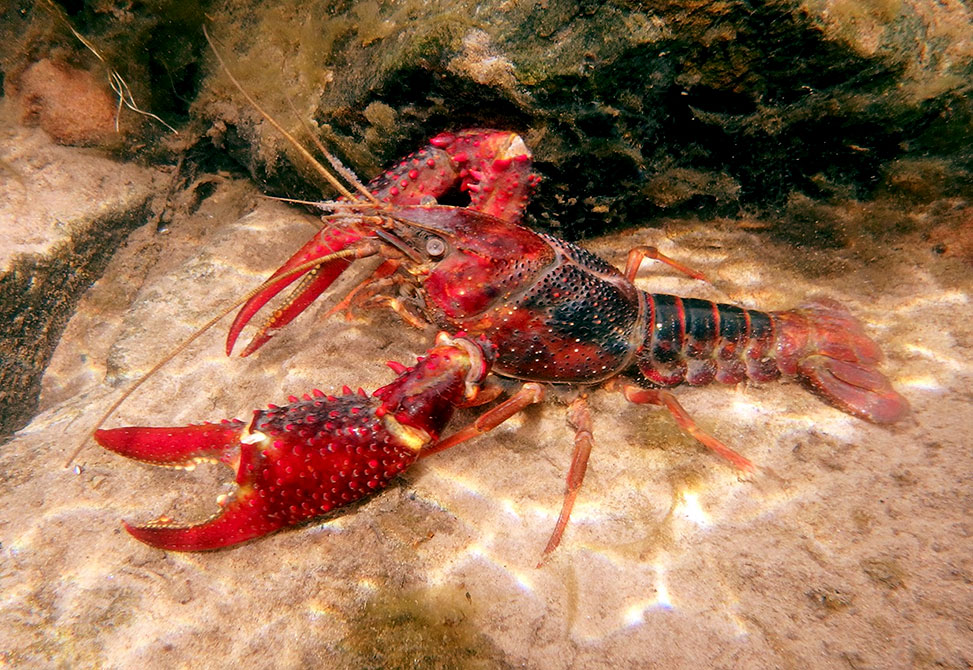Aquaporin Bridge
Reflecting work in the Wang Lab
Researchers from the Wang Group at the School of Life Sciences, Shandong University, China, report in PNAS a mechanistic bridge between two pillars of arthropod antibacterial defense. Their study shows that reactive oxygen species generated outside cells by dual oxidase 2 feed directly into the transcriptional program that drives antimicrobial peptide expression. The conduit is an aquaporin, Aqp4, identified in the red swamp crayfish Procambarus clarkii. Aqp4 transports extracellular hydrogen peroxide into hemocytes, where the intracellular rise in reactive oxygen species activates c-Jun N-terminal kinase, promotes nuclear translocation of FoxO, elevates Relish transcription, and increases Relish-target antimicrobial peptides. This sequence, ROS to Aqp4 to FoxO to Relish to AMPs, couples rapid oxidative killing with a longer lived peptide response and thereby strengthens and prolongs host defense.
The authors first uncovered Aqp4 as a bacteria responsive factor through RNA sequencing of hemocytes and intestine after Aeromonas hydrophila exposure, then confirmed upregulation by quantitative PCR. Functional tests using RNA interference showed that loss of Aqp4 increased pathogen load and mortality, and produced intestinal damage during infection, which places Aqp4 upstream of an effective antibacterial program. Notably, Aqp4 knockdown did not blunt the production of extracellular reactive oxygen species itself, which indicates that the aquaporin acts as a signaling gate rather than as a generator of oxidants.

Figure 1. Identification of Aqp4 as a key factor in crayfish antibacterial immunity.
A| Induction of Aqp4 transcripts abundance by A. hydrophila infection, 2 × 106 CFU. RNA-seq was performed 12 h after bacterial infection. The FPKM value obtained from RNA-seq was used to represent the transcript abundance.
B| Temporal expression profiles of Aqp4 in hemocytes, left, and intestine, right, after A. hydrophila oral infection, as detected by qPCR with β-actin as internal reference. C| Crayfish survival analysis after Aqp4 knockdown, in the absence, left, or presence, right, of A. hydrophila infection. Aqp4 siRNA, 5 µg/g animal, was injected into the crayfish hemocoel. Scrambled siRNA which shares the same nucleotide composition as the testing siRNA but lacks significant sequence similarity to any known mRNA was used as control. Oral infection with A. hydrophila, 107 CFU/animal, was performed 24 h after siRNA application. Crayfish mortality was recorded daily after siRNA application, left, n = 30, or Aqp4 knockdown plus oral infection, right, n = 60. Data are representative of three biological replicates. D| Load of A. hydrophila after Aqp4 knockdown. A. hydrophila, 1 × 105 CFU, was delivered orally into crayfish intestine after Aqp4 knockdown. After 48 h, the intestinal DNA was collected. A. hydrophila 16S rDNA abundance was determined using qPCR with specific primers, and calibrated to host β-actin. E| Intestinal morphological analysis following Aqp4 knockdown and subsequent oral infection with A. hydrophila. The intestinal tract was dissected 5 d after infection, and hematoxylin-eosin staining was performed. Scale bar, 250 μm. Images are representative of three biological replicates.
To isolate the reactive oxygen species branch without confounding peptidoglycan signals, the team used uracil, a bacterial metabolite that selectively triggers Duox2 dependent extracellular hydrogen peroxide. Uracil raised intracellular reactive oxygen species and hydrogen peroxide in hemocytes, an effect lost when Duox2 was silenced. Blocking aquaporin function with Aqp4 knockdown or the aquaporin inhibitor TGN020 eliminated uracil driven FoxO nuclear entry and reduced FoxO binding at the Relish promoter. Quenching extracellular oxidants with ascorbate also prevented FoxO activation. These manipulations converge on a single interpretation, extracellular hydrogen peroxide enters through Aqp4, activates JNK, and enables FoxO to upregulate Relish.
Linkage to effector output was established by measuring transcripts and proteins for Relish targets such as Alf3 and Eiger. Uracil induced these antimicrobial genes, while Duox2 knockdown, Aqp4 inhibition, FoxO knockdown, or Relish knockdown each reduced the response. The biology of the link proved consequential. Uracil pretreatment lowered intestinal bacterial burden and improved survival after A. hydrophila challenge, and this protection required Duox2, Aqp4, FoxO, and Relish. Temporal profiling highlighted why the bridge matters. Extracellular reactive oxygen species peaked early and returned to baseline within a day, yet antimicrobial peptide levels remained elevated at 24 hours, which explains the extended immune effect once signaling crosses from oxidants to gene expression.
The work also clarifies pathway boundaries. Peptidoglycan, modeled with muramyl dipeptide, still drove FoxO activation without a requirement for Aqp4, which suggests parallel inputs into FoxO. By contrast, the uracil to Duox2 route strictly required Aqp4 to deliver the oxidant signal into the cytosol. The authors further showed negative control of Dilp6 is irrelevant here, and instead focused on how insulin related nodes are not central to the crayfish axis. Conservation tests in kuruma shrimp reproduced the Aqp4 dependent regulation of FoxO, Relish, and antimicrobial output, which argues that aquaporin mediated hydrogen peroxide signaling is a general arthropod solution for linking oxidative and peptide defenses.
Conceptually, this study reframes the Duox2 and Relish branches as a coordinated sequence rather than isolated arms. Extracellular oxidants act as both microbicidal agents and second messengers that commit tissues to sustained peptide production once Aqp4 imports the signal. The result is more potency and longer duration for antibacterial immunity. The authors note an intriguing parallel in plants, where apoplastic oxidants generated by RBOH enzymes enter through plasma membrane intrinsic protein aquaporins to engage defense gene expression, which hints at convergent evolution for oxidant to transcription coupling across kingdoms. In arthropods, the ROS to Aqp4 to FoxO to Relish axis now provides a concrete framework to probe how immune signals traverse membranes, how tissues tune the balance between immediate oxidative attack and durable peptide based control, and how pathogens might evade both by targeting aquaporin gates.


